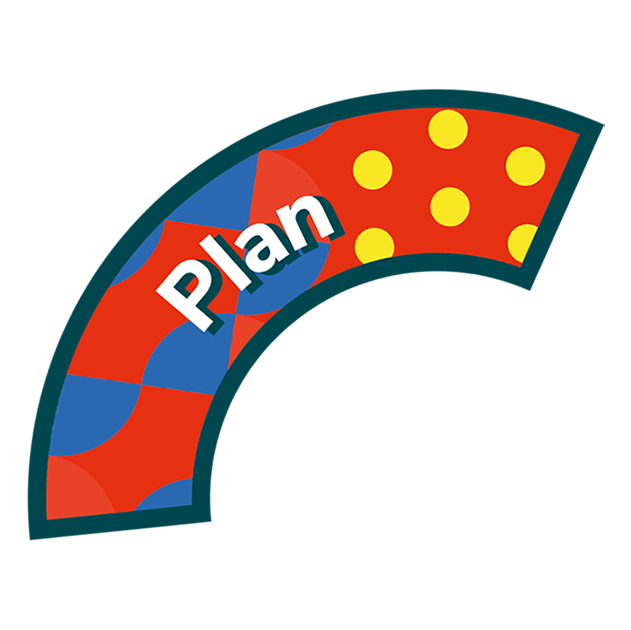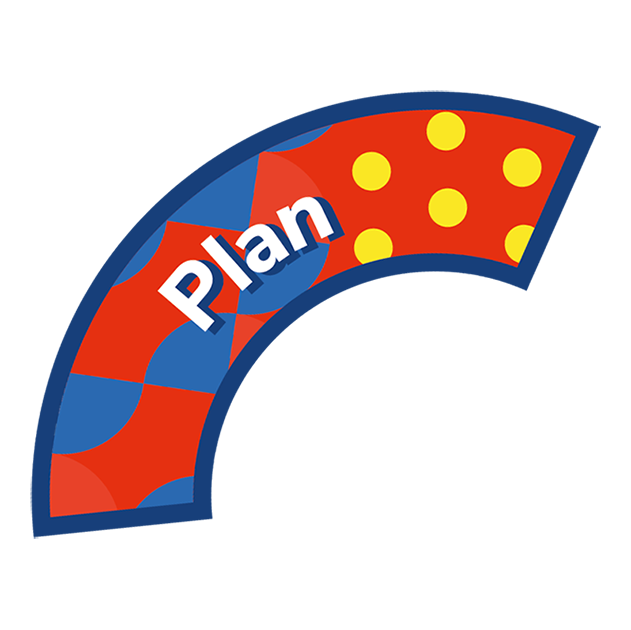Programme planning pros
You’ll need
- Scrap paper
- Coloured pens or pencils
- Rulers
- Calculator or phone
- Flipchart, whiteboard or A3 paper
- Marker pens
- Devices with internet access
Before you begin
- This is an activity that requires everyone to think about some of their best experiences on nights away and work together to organise a camp programme. It may be best to run this activity before or after an active game, so the session doesn’t get too heavy. It’s also a good idea to run this session some time in advance of the trip. Planning nice and early will increase the likelihood that externally led activities will be available and allows leaders to get in touch with providers with any accessibility questions they may have.
- Find out what you can about facilities available for activities at the site you’re visiting and those that are reachable in the surrounding area. Do this with or without the group the week before the programme planning session.
- Think about which activities might need to be led by external instructors and which can be led by leaders and helpers. Use the activity finder to help find adventures, especially if taking part in activities that require permits.
- Leaders should have a think about the resources they find useful when planning a programme of activities. They might want to bring past plans with them, as well as any notes and useful training materials. Modules F-H of The Explorer Scout Young Leader delivery book could help, as they cover ‘Making Scouting accessible and inclusive’, ‘What is a high quality programme’ and ‘Programme planning’.
- Think carefully about a goal for the session and the night away as a whole. Factor in time constraints, budget and other considerations. Here’s an example: ‘By the end of this session, we want to have planned two full days of activities, using our £250 budget. We’ll need to include a younger group in our Saturday afternoon plans’. If your wider programme has you working around a theme (like science or the environment), this will need to be considered too.
A matrix is a visual tool used to display information and the relationship between different pieces of information. In this activity, the tool used will be a simple table. This table is useful for organising the ideas of different people into one model that shows the ideas most suited to your camp and the ideas least suited to your camp.
Making your matrix
- Write up the goal for this session somewhere everyone can see it, such as on a whiteboard or on a large sheet of paper. As well as the task at hand, planning a programme for the night away, other considerations, like a theme, a budget and time constraints, could also be displayed. Explain that everyone will be using their best memories of previous experiences to make this night away the best ever.
- Everyone should split into the groups that they’ll be in on the night away. Each group will need pens and pencils, paper, a large sheet of paper or whiteboard (with a marker), a calculator and coloured pens or pencils.
- Each group should draw up a table similar to the one below. Make sure this is nice and big, with big squares to write in. Try not to use more than 10 columns and rows, to make the information easier to read.
| Activity A | Activity B | Activity C | Activity D | Activity E | Total | |
| Physically challenging | 10 | 0 | 5 | 0 | 10 | 25 |
| New for everyone | 10 | 2 | 5 | 10 | 10 | 37 |
| All-weather | 10 | 10 | 5 | 10 | 0 | 35 |
| Involves sharing or storytelling | 0 | 5 | 5 | 10 | 0 | 20 |
| Relaxing | 0 | 8 | 5 | 10 | 0 | 23 |
| Total | 30 | 25 | 25 | 40 | 20 |
- Groups should now work together to fill in the first boxes on the rows of their table with features of a balanced programme. These will be the criteria that help you choose your camp activities. We’ve used ‘Physically challenging’, ‘New for everyone’, ‘All-weather’, ‘Involves sharing/storytelling’ and ‘Relaxing’, but the groups should pick the activity features that matter to them and that relate to the wider programme.
- On another sheet of paper, the groups should now list the different kinds of activity that they know. These might be described as ‘winding down activities’ (more sedate games or craft sessions), ‘adventurous outdoor sports’ (like orienteering) or ‘wide games’ (like ‘Capture the flag’). Groups should think of as many different kinds as they can.
Sourcing ideas
- Leaders and helpers with experience of programme planning should take five minutes to explain how they like to organise activities. At this point, they should take the opportunity to talk about how important factors like accessibility, inclusion, and health and safety are to this kind of planning. They should also remind everyone to keep the goal of the session, written up where they can see it, in mind throughout.
- Now, share information with the groups about facilities and activities on offer at or nearby the site. They can now begin to source ideas for potential programme fillers.
- Groups should spend about 20 minutes exploring the resources available and try to find specific activities that match one, some or all of their criteria. When they’ve collected a good number of activities, write each one in the top box of a column on the table.
- Groups should think carefully about their chosen activities. Those who’ve taken part in them before should talk about their experience. They should then think about how each activity relates to the chosen criteria in each row heading. For each activity, groups should agree on a rating out of 10, based on how well each activity meets each aspect of the criteria. They should then total these ratings in the final column with a calculator to get a score for each activity.
- When all of the scores have been worked out and compared, discuss as a group how well the chosen activities fit the criteria for the upcoming night away. Talk about any criteria that weren’t met so well, or any that could benefit from having less focus.
- Take the opportunity to try out any new activities suggested, to see how well they fit the criteria. This might help everyone agree on the right blend.
- Each group can try fitting activities into rough timetables. Everyone will have to think about how these fit around daily routines, like mealtimes. Take a look at the dropdown boxes below for some other considerations.
While there’ll be some uncertainties about the adventurous activities everyone will take part in, there are some things you already know that can be slotted into rough timetables.
- Everyone will be having three meals a day. Have a think about what you’d like to have and how you might prepare it. Guidance on preparing food and cooking at camp can be found in Camping and practical skills. You may need a whole separate session for meal planning. If so, take a look at Camp cuisine.
- Everyone will definitely want comfort breaks and periods of free time.
- Everyone will need time to set up and take down the campsite.
- Each group can include any games or activities that don’t require external providers or permits.
Each group is unlikely to be able to finalise their plans during this meeting, but they should be able to come up with a list of actions to help prepare further. This might include some of the following:
- Speaking to external providers about booking adventurous activities
- Deciding a mode of travel if any of the activities planned are offsite
- Getting parents or carers permission, where necessary, for any activities planned.
- Chatting to other groups, if you’re planning on including them in your programme.
- Potentially seeking out more adult helpers to come along to camp.
- Chatting to leaders about what sort of risk assessments they’ll be making.
Reflection
Everyone’s priorities and preferences are usually different. One person’s most memorable camping experience might’ve been very different for someone else. This was a chance to talk openly with others about what you enjoyed and what you didn’t, as well as what you’d like to try in the future. The aim was to work out a compromise that suits everyone, which relied on teamwork and organisation.
This can be done by choosing broad criteria, like ‘trying new things’ or ‘problem-solving as a team’. Have a think during this exercise about what compromise can teach us and the benefits of finding similarities with our peers, rather than differences.
Safety
All activities must be safely managed. You must complete a thorough risk assessment and take appropriate steps to reduce risk. Use the safety checklist to help you plan and risk assess your activity. Always get approval for the activity, and have suitable supervision and an InTouch process.
- Online safety
Supervise young people when they’re online and give them advice about staying safe. Take a look at our online safety or bullying guidance. The NSPCC offers more advice and guidance, too. If you want to know more about specific social networks and games, Childnet has information and safety tips for apps. You can also report anything that’s worried you online to the Child Exploitation and Online Protection Command. As always, if you’ve got concerns about a young person’s welfare, including their online experiences, follow the Yellow Card to make a report.
Using a matrix like the table in this activity is just one way of organising ideas and priorities. Opinion polls and Venn diagrams could also be used to pinpoint those positive programme gems.
Adding up scores for lots of different things can be a bit daunting for those who aren’t comfortable with maths. Be sure to provide calculators or phones with this function.
All Scout activities should be inclusive and accessible.
The next step is to get everyone’s programmes finalised and carry out the activities at camp! This will help those who’ve made plans to complete their Scouts Camper Activity Badge. If they want somewhere to display their itineraries while they’re at camp, then take a look at Build a bulletin board.
Young people are shaping their entire camp experience in this planning activity.


